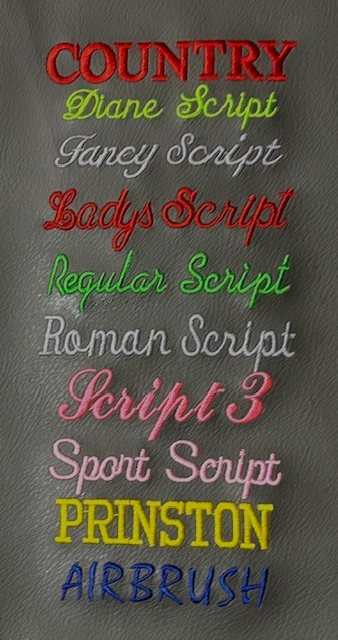The Art of Custom-made Needlework: Opening the Secrets to Creating Unique and Remarkable Styles
Needlework, a craft steeped in tradition and virtuosity, holds within its detailed stitches the power to change material right into a canvas of special expression. The tricks to producing custom embroidery designs that captivate the eye and leave an enduring impact hinge on a delicate balance of strategy, imagination, and interest to detail. As we dig right into the globe of customized needlework, we discover the nuanced interplay between thread selection, sew intricacy, and design personalization that elevates a plain garment to an artwork. Join us on a trip via the art of custom needlework as we decipher the enigmas behind crafting really extraordinary and distinctive developments.
Choosing the Right Needlework Threads
When choosing needlework threads, what essential aspects should you think about to make sure the very best outcomes for your custom-made designs? The selection of embroidery string is essential in identifying the last outcome of your embroidered layout. Among the key considerations is the product of the thread. Various products such as cotton, polyester, rayon, and silk supply differing levels of shine, toughness, and appearance. It is vital to pick a thread material that complements the fabric you are embroidering on and straightens with the preferred look of the style.
Additionally, the weight or density of the string plays a substantial function in the look of the embroidery. Thicker strings can include measurement and texture to your style, while finer strings are excellent for detailed information and little text. In addition, considering the shade fastness and washability of the string is essential to make sure that your custom-made layouts maintain their top quality and vibrancy with time. By very carefully reviewing these variables and selecting premium threads that fulfill your specific demands, you can boost the visual allure and long life of your embroidered productions.
Checking Out Different Stitch Techniques
To dive right into the realm of 'Discovering Different Stitch Methods', one should grasp the intricacies and nuances that each stitching approach offers the art of embroidery. Different stitch strategies not only add visual rate of interest but likewise contribute to the total structure and dimension of the style. One prominent stitch technique is the satin stitch, which includes carefully jam-packed parallel stitches to produce a smooth and shiny surface, ideal for filling out shapes and developing bold describes.
On the various other hand, the backstitch is a versatile technique commonly made use of for outlining and adding fine details. It includes stitching backward to develop a solid line of embroidery. Additionally, the French knot stitch adds a tactile aspect to layouts, best for developing distinctive accents like blossom centers or ornamental touches.
Checking out different stitch methods permits embroiderers to have fun with light, shadow, and depth within their designs, raising the visual charm and imaginative quality of their embroidery jobs. By grasping different sewing read what he said approaches, one can unlock countless opportunities for developing one-of-a-kind and remarkable custom embroidery items.
Incorporating Personalized Design Aspects
Having actually checked out the ins and outs of various stitch methods such as the satin stitch, backstitch, and French knot, the emphasis now shifts in the direction of integrating tailored design components in personalized embroidery tasks. Customized layout components play an essential role in making embroidery tasks absolutely special and remarkable.
One more method to integrate tailored design aspects is by consisting of symbols or concepts that hold special significance to the recipient or mirror their interests and individuality. Including a preferred blossom, animal, or hobby-related symbol can make the embroidery design much more significant and customized. Furthermore, picking shades that resonate with the recipient or straighten with the intended theme can better boost the personalization of the needlework project.
Grasping the Art of Shade Coordination

One secret element of color sychronisation is understanding shade theory. This includes recognizing exactly how various colors communicate with each other, the emotions they communicate, and just how they can be integrated to develop visually attractive layouts. By using shade concept principles, embroiderers can create unified color combinations that improve the overall look of the design.
Furthermore, paying attention to contrast is important in color control. see page Making use of contrasting colors can assist certain elements of the design pop, improve readability, and produce a visually vibrant embroidery item. By understanding the art of color coordination, embroiderers can raise their layouts and develop unforgettable items that reverberate with customers and visitors alike.
Enhancing Appearance With Advanced Needlework Stitches
French knots, as an example, are excellent for adding small, raised dots to your layout, imitating the appearance of grains or developing a textured surface. Bullion knots, on the other hand, can be utilized to develop twisted, ropelike components that include a lavish feeling to the needlework. Seed sewing includes little, scattered stitches that can complete areas with a multicolor appearance, while turkey work creates cosy, dimensional accents similar to pet fur or foliage. Trying out these sophisticated needlework stitches enables you to push the limits of conventional embroidery and develop really distinct and aesthetically enticing textures in your styles.
Verdict
Finally, the art of personalized needlework involves a mix of choosing the ideal threads, checking out numerous stitch methods, integrating individualized style components, grasping color coordination, and improving texture with innovative stitches. By comprehending and applying these crucial elements, embroiderers can produce distinct and memorable designs that display their creative thinking and skill. Embroidery enthusiasts can unlock the tricks to creating lovely and custom items that stand apart and leave an enduring impression.